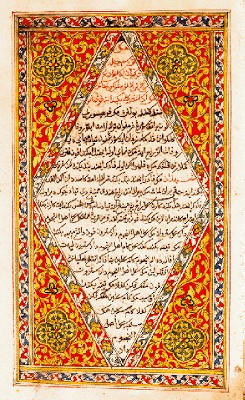
The Malay Annals, originally titled Sulalatus Salatin, is a literary work that gives a romanticised history of the origin, evolution and demise of the great Malay maritime empire, the Malacca Sultanate. The work, which was composed sometime between the 15th and 16th centuries, is considered one of the finest literary and historical works in the Malay language.

The Lantaka also known as rentaka was a type of bronze portable cannon or swivel gun, sometimes mounted on merchant vessels and warships in Maritime Southeast Asia. It was commonly equipped by native seafaring vessels from the Philippines, Indonesia, Brunei, and Malaysia. Lela and rentaka are known by the Malays as meriam kecil, the difference is that rentaka is smaller in length and bore than a lela. and Lantakas are often called Kanyon in Filipino.
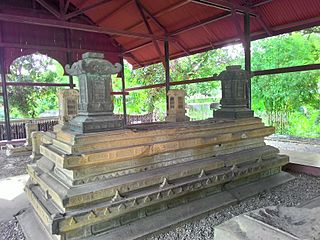
Alauddin Ri'ayat Syah al-Kahar was the third Sultan of the Aceh Sultanate, reigning from either 1537 or 1539 until his death. He is considered to be one of the strongest rulers in the history of the sultanate and greatly strengthened Aceh. Alauddin's reign was marked by increased conflict with his Portuguese and Malay rivals and his dispatching of envoys to the Ottoman sultan, Suleiman the Magnificent in the 1560s.

Flor do Mar or Flor de la Mar, spelled Frol de la Mar in all Portuguese chronicles of the 16th century, was a Portuguese nau (carrack) of 400 tons, which over nine years participated in decisive events in the Indian Ocean until her sinking in November 1511. Nobleman Afonso de Albuquerque was returning from the conquest of Malacca, bringing with him a large treasure trove for the Portuguese king, when the ship was lost off the coast of Sumatra. A replica of Flor do Mar is housed in the Maritime Museum in Malacca, Malaysia.
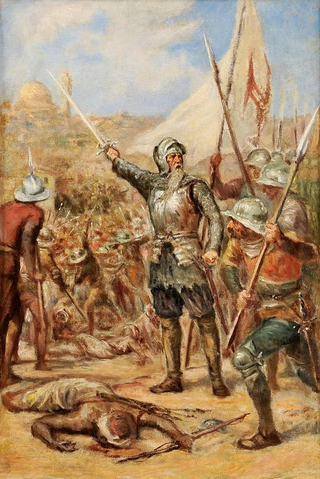
The Capture of Malacca in 1511 occurred when the governor of Portuguese India Afonso de Albuquerque conquered the city of Malacca in 1511.

A Borobudur ship is the 8th to 9th-century wooden double outrigger sailing vessel of Maritime Southeast Asia depicted in some bas reliefs of the Borobudur Buddhist monument in Central Java, Indonesia. It is a ship of Javanese people, derivative vessels of similar size still survived in East Java coastal trade at least until the 1940s.
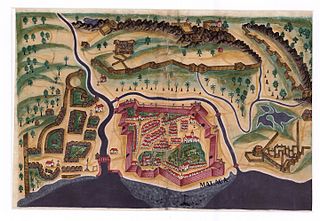
The Battle of Duyon River was a naval engagement between the Portuguese forces commanded by Nuno Álvares Botelho, who is renowned in Portugal as one of the last great commanders of Portuguese India, and the forces of the Sultanate of Aceh, which were led by Lassemane.
Cetbang were cannons produced and used by the Majapahit Empire (1293–1527) and other kingdoms in the Indonesian archipelago. There are 2 main types of cetbang: the eastern-style cetbang which looks like a Chinese cannon and is loaded from the front, and the western-style cetbang which is shaped like a Turkish and Portuguese cannon, loaded from the back.

Garay were traditional native warships of the Banguingui people in the Philippines. In the 18th and 19th centuries, they were commonly used for piracy by the Banguingui and Iranun people against unarmed trading ships and raids on coastal settlements in the regions surrounding the Sulu Sea.
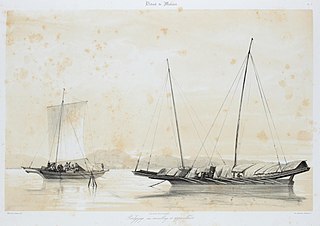
Penjajap, also pangajava and pangayaw, were native galley-like warships used by several Austronesian ethnic groups in maritime Southeast Asia. They were typically very long and narrow, and were very fast. They are mentioned as being used by native fleets in Indonesia, the southern Philippines, Malaysia, and Brunei.

A lancaran or lanchara is a type of sailing ship used in Maritime Southeast Asia. Although similar in shape to Mediterranean galleys, the lancaran was the backbone of the regional fleet of the western half of Nusantara before Mediterranean influence came. For their war fleet, the Malays prefer to use shallow draught, oared longships similar to the galley, such as lancaran, penjajap, and kelulus. This is very different from the Javanese who prefer long-range, deep-draught round ships such as jong and malangbang. The reason for this difference is that the Malays operated their ships in riverine water, sheltered straits zone, and archipelagic environment, while the Javanese are often active in the open and high sea. After contact with Iberian people, both the Javanese and Malay fleets began to use the ghurab and ghali more frequently.

The djong, jong, or jung is a type of sailing ship originating from Java, Indonesia that was widely used by Javanese, Sundanese, and later, by Malay sailors. The word was and is spelled jong in its languages of origin, the "djong" spelling being the colonial Dutch romanization. In English, the djong lends its name to other ships of similar configuration, called junks, and to their characteristic style of rigging, the junk rig.

Kelulus or kalulus is a type of rowing boat used in the Nusantara archipelago. It is typically small in size and propelled using oar or paddle. However, for long-distance voyages, this boat can be equipped with sails. It is not the same as prahu kalulis of the eastern part of the Indonesian archipelago.

Pencalang is a traditional merchant ship from Nusantara. Historically it was called as pantchiallang or pantjalang. It was originally built by Malay people from the area of Riau and the Malay Peninsula, but has been copied by Javanese shipwrights. By the end of the 17th century this ship has been built by Javanese and Chinese shipbuilders in and around Rembang. However it was a popular choice for Balinese skippers followed by Sulawesian skippers.
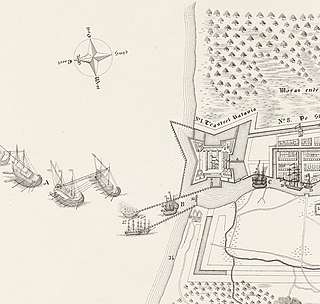
Malangbang or melambang is a type of medieval sailing ship from Indonesia. It is mentioned mainly in the History of Banjar. The name "malangbang" is considered to originate from the Old Javanese language, malabong (malaboṅ) which refers to a particular type of boat. Malangbang is one of Majapahit's main naval vessel types after jong and kelulus. Not much is known about this type of ship, apart from the fact that it also used oar beside the sails to propel it, broad and flat-bottomed, and was a "medium-sized" ship, between the size of jong and kelulus, larger and faster than pilang (pelang).

Ghurab or gurab is a type of merchant and warship from the Nusantara archipelago. The ship was a result of Mediterranean influences in the region, particularly introduced by the Arabs, Persians, and Ottomans. For their war fleet, the Malays prefer to use shallow draught, oared longships similar to the galley, such as lancaran, penjajap, and kelulus. This is very different from the Javanese who prefer long-range, deep-draught round ships such as jong and malangbang. The reason for this difference is that the Malays operated their ships in riverine water, sheltered straits zone, and archipelagic environment, while the Javanese are often active in the open and high sea. After contact with Iberian people, both the Javanese and Malay fleets began to use the ghurab and ghali more frequently.
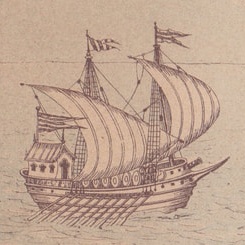
Mendam Berahi was a legendary royal galley said to have been used by the Malacca Sultanate in the 16th century. This ship is actually just a fictional ship because it was only recorded in the fictional literature Hikayat Hang Tuah, and its type, the ghali, did not exist until after the 1530s.
The Battle of Formoso River of 1615 was an naval battle that took place in the Malay peninsula within Formoso River, between a Portuguese fleet and a large fleet of the Sultanate of Aceh, one of the largest Aceh had ever mobilized against the Portuguese in Malacca.

Acehnese–Portuguese conflicts were the military engagements between the forces of the Portuguese Empire, established at Malacca in the Malay Peninsula, and the Sultanate of Aceh, fought intermittently from 1519 to 1639 in Sumatra, the Malay Peninsula or the Strait of Malacca. The Portuguese supported, or were supported, by various Malay or Sumatran states who opposed Acehnese expansionism, while the Acehnese received support from the Ottoman Empire and the Dutch East India Company.




























